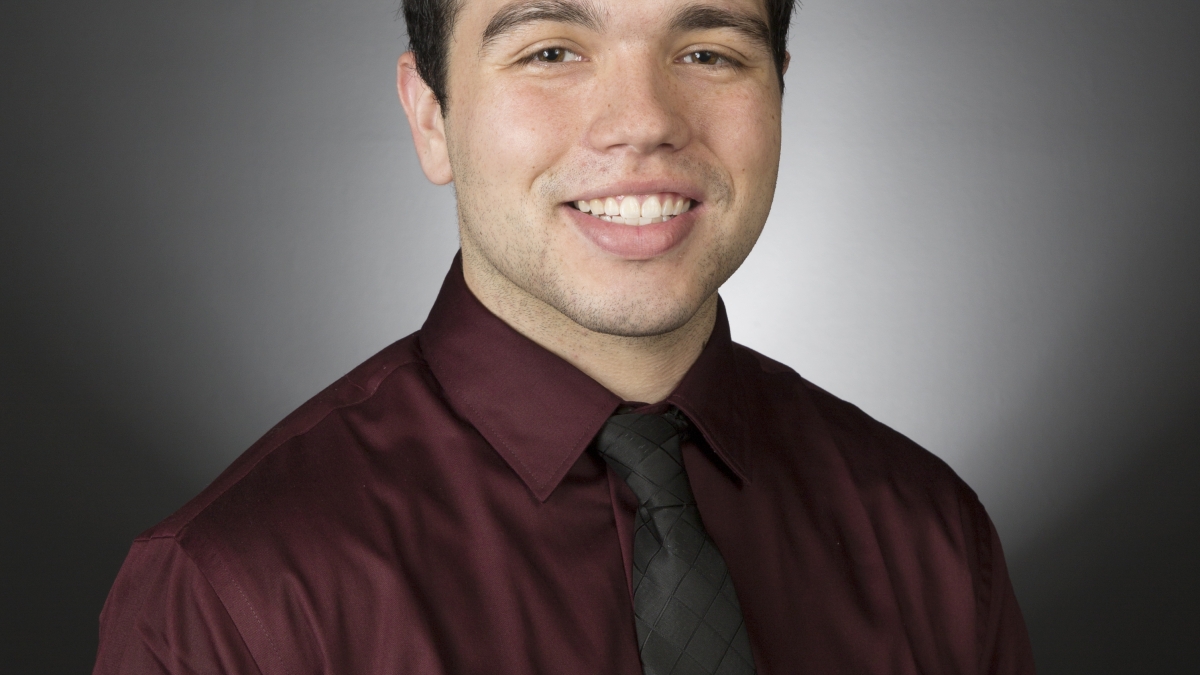Editor's note: This is part of a series of profiles for spring 2016 commencement. See the rest here.
Jorge Cardenas’ undergraduate years as an electrical engineering student at Arizona State University have been a mixture of helping others to succeed and achieving great success himself.
A Tucson, Arizona native, his stellar academic performance and dedication to research earned him the Gary and Dianne Tooker Scholarship for Engineering in 2013 and 2014. As a freshman he received the New American University Dean’s Award. As a senior, his culminating achievement comes in the form of a Graduate Research Fellowship from the National Science Foundation, the nation’s premier graduate fellowship award for students in science, technology, mathematics and engineering fields.
Cardenas mentored electrical engineering students as a student mentor for two semesters. He was also a tutor at ASU’s Math Tutoring Center for five semesters. As a freshman he tutored middle school students through ASU's support for the America Reads program.
Part of what made Cardenas an outstanding tutor was the empathy he gained from his own academic struggles in high school. “I was not a particularly focused individual in high school … so the transition to ASU was tough,” Cardenas said.
“He is graduating with an impressive academic track record with a more-than-perfect GPA, despite coming from a high school background where he was an average student,” said Michael Goryll, an associate professor, who complimented Cardenas on overcoming this challenge.
Cardenas chose electrical engineering because he wanted to leverage innovation in electronics to contribute to societal growth and advancement. As a Fulton Undergraduate Research Initiative (FURI) student working in professor Yong-Hang Zhang's lab, he tackled an ambitious semiconductor characterization project, which could contribute to the growth of new materials to be applied to high-performance solar cells.
In summer 2015, he secured an internship at Duke University where he studied nanomaterial electronics, which will eventually result in a co-authored publication in a refereed journal. It has also contributed to two scientific conference proceedings.
His connections during his summer internship led to his acceptance to a PhD program in electrical engineering at Duke University beginning in the fall. He was also admitted to Cornell University, University of Michigan and Purdue University.
“Jorge is one of the students who is able to combine his passion for helping others with his curiosity to explore new frontiers in research, while demonstrating academic success at the highest level,” Goryll said.
Question: Tell me how engineering (or your engineering) will change the world.
Answer: The development of new technology is an economic engine, and without engineers society cannot grow. Electrical engineers have been at the forefront of growth for the past century, and my degree will allow me to contribute to the creation of new industries as well as help continue to advance technologies in medical, solar and electronic industries, which will improve the quality of life for all.
Q: Was there a particular “aha!” moment when you knew that you were on the right path?
A: I think the most memorable moment for me at ASU was my experience in my senior design class. My team developed a low-cost Hall measurement system, and I had a blast working with my teammates and a great professor, Dr. Zachary Holman. We successfully built a commercial-grade semiconductor measurement system that Dr. Holman will use in his research lab. I will continue to work with Dr. Holman this summer to ensure the system operates as designed and publish an Application Note on the design.
Q: What are your plans after graduation? Graduate school? Do you have a job lined up?
A: After graduation I will pursue a PhD at Duke University. I plan to continue to study and research nanomaterial devices, as well as explore other applications using nanomaterials, such as printed electronics.
Q: How do you see your future? What is your dream for your life?
A: My long-term goals include one of the following: 1. Working on a research and development team at a national semiconductor company to create new devices that will continue the kind of technological growth that we’ve seen over the past few decades, or 2. Becoming an entrepreneur and creating products that enable the growth of new industries that are based on new and non-traditional electronic devices.
Q: What has been most rewarding about your undergraduate years at ASU? What has been most challenging?
A: The most challenging part of my undergraduate degree was my transition from high school to college. I was not a particularly focused individual in high school … so the transition to ASU was tough. The most rewarding part of my degree is the improved qualities of self-discipline and perseverance I got out of the experience. The experience has proven to me that success is not inherited, and that anyone can make a big impact on the world with the right mind-set, no matter where they come from.
More Science and technology

ASU-led space telescope is ready to fly
The Star Planet Activity Research CubeSat, or SPARCS, a small space telescope that will monitor the flares and sunspot activity…

ASU at the heart of the state's revitalized microelectronics industry
A stronger local economy, more reliable technology, and a future where our computers and devices do the impossible: that’s the…

Breakthrough copper alloy achieves unprecedented high-temperature performance
A team of researchers from Arizona State University, the U.S. Army Research Laboratory, Lehigh University and Louisiana State…


